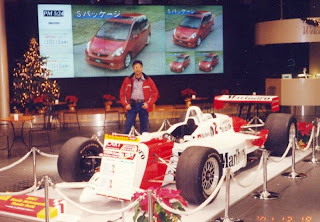Improvements can be achieved thru step-by-step incremental progress or thru a-big-breakthrough-jump .... this is basic difference between Japanese way & West way of doing.
If lean production represents the core of "the Japanese miracle," there are two other ingredients that, until relatively recently, were also considered indispensable parts: the doctrine of continuous improvement, or kaizen, and the value of consensus, especially when applied to long-term strategic thinking. A good way to look at both is through the work of Kenichi Ohmae.
Mr. Ohmae is now best known inside Japan for his attempt to set up a new political party. But he began to write the books that made his name in the rest of the world while working as a consultant for McKinsey & Company.
For most of the past quarter century, outsiders, particularly American business people, have been fascinated and frightened by Japan. Mr. Ohmae has explained it to them -- showering his books with good insider examples of how Japanese companies work and usually criticizing American firms in the process.
Mr. Ohmae has generally tended to exalt the Japanese way of making new products through continuous improvement. Innovation, he argues, is useless unless it adds value for consumers. He tends to pour scorn on big R.&D. projects, such as high-definition television, and revels in meeting challenges incrementally, particularly in mundane fields. Can you make a better coffee machine -- i.e., not just one with lots of fancy gadgets but one that makes better coffee? Yes, we discover, if you add a water purifier, because the taste of coffee depends as much on the quality of the water as it does on how you percolate the beans. Can you make a better camera? Yes, if you get it to do the focusing for you (i.e., removing the human error that ruins most pictures) and include an automatic flash.
A strategy of churning out products with lots of minuscule improvements fits in quite nicely with lean production. After all, one advantage of a flexible assembly line is that it can be altered quite easily to incorporate a new insight and include a new innovation. It also means that you can smother your market with new versions of the same old thing. One classic example of this process was the Sony Walkman, which came in hundreds of different shapes and sizes. Japanese companies such as Sharp and Canon have often jumped ahead by mixing different sorts of technology, such as photography and office machines. One way Japanese car makers have generally outfoxed their rivals is by rapidly updating their model range and adding extras such as vanity mirrors and intermittent windshield wipers. By contrast, American and European manufacturers have seemed obsessed with a "one big solution'' approach to research.
The trick of Japanese management is to marry this relentless incrementalism to a long-term strategy based on consensus. Mr. Ohmae points out that while Western companies modeled themselves on the military, with clear lines of command and a rigid distinction between the officers (who do the thinking) and the rest, Japanese firms are rooted in village communes."Grossly oversimplifying," Mr. Ohmae writes, "one could say that in Japan every member of the village is equal and a generalist." Rather than issuing orders from on high, Japanese companies prefer to put their emphasis on nemawashi (consensus building) and ringi (shared decision-making). The hope is that every decision will spring from tireless discussion, with managers obliged to gain the enthusiastic support of their workers.
This emphasis on communal decision-making means that the Japanese have an idiosyncratic approach to leadership. Where American bosses are brash and bullying, their Japanese counterparts are modest and retiring; and where Americans live to make decisions, the Japanese prefer to let decisions make themselves. They like to compare leadership to air -- necessary for life but invisible and insubstantial. They rise up the corporate ranks by out-conforming their colleagues, religiously putting the group before the individual, and, having reached the top job, lead by consensus rather than command. It is not unusual for leaders to sit in silence throughout much of a meeting, while their underlings debate the pros and cons of policy. The art of leadership is to divine the will of the group, not to electrify the organization with charisma.
It also means that the Japanese have an idiosyncratic approach to forming long-term strategy. In the West, strategy has traditionally been clear and definite, drawn up by professional strategists and written down in formal plans. In Japan, it is a much looser affair, generated by the whole organization and expressed in terms of visions and missions rather than precise plans.To the Western mind, producing plans like this is a recipe for disaster. But, according to Mr. Ohmae, the Japanese can do it because it fits in with their general approach to employment. The system of lifetime employment means that core workers identify with the long-term future of the company. The habit of rotating people among different departments means that they soon come to think like strategists. And the convention that everybody must start on the shop floor means that senior managers know what is going on in the guts of their organizations.
Wednesday, May 21, 2008
Kaizen and Consensus < Part-2 / Japanese Management : Art and Practice > ...
Subscribe to:
Post Comments (Atom)







No comments:
Post a Comment